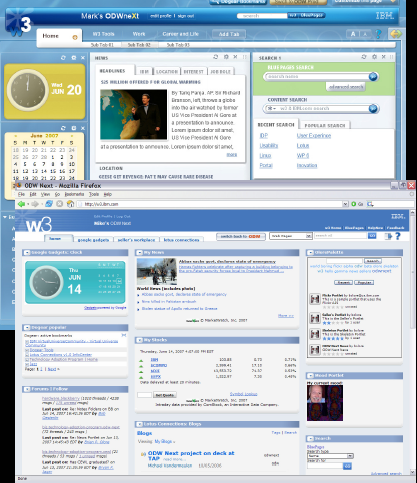IBM demos 'On Demand Workplace'; Will Web 2.0 deliver productivity gains?

IBM demoed its enterprise 2.0 experiments Tuesday including its On Demand Workplace--an application that's part intranet, part Facebook and part Web service that becomes an interface to legacy systems.
IBM executives held court with a handful of bloggers, writers and analysts at its New York offices. The presentations, currently underway, are led by CIO Mark Hennessy and focus on enabling innovation and redesigning the workplace so every employee can contribute ideas and utilizing Web 2.0 concepts.
Big Blue's challenge: Herding and harnessing 372,000 employees. Hennessey noted that his job as CIO is to simplify, transform and innovate. That's easier said than done.
However, IBM may be on to something. One of the more interesting presentations came from Michael Van Der Muelen, IBM's chief architecture architect. Van Der Muelen walked through IBM's experimental intranet dubbed the "On Demand Workplace," or ODW.
Here's a look:
ODW was launched in January and was designed to incorporate IBM communities and the technology adoption program. While IBM workers have to use the company's production systems ODW could become the window to work.
Thus far, ODW has about 21,000 users in 83 countries. Any employee can sign up for ODW via its technology adoption program site. IBM is hoping to get about 10 percent of its employee base using ODW to garner a statistically relevant mass of feedback.
If all goes well, ODW will be rolled out as a standard. The call will be Hennessey's. "We have to make sure productivity savings will be there," said Hennessey. "One of my priorities is to drive productivity in the field teams."
Hennessey's comments are why Van Der Muelen's pitch was interesting to me. Big Blue's experiment will show where enterprise 2.0 meets the ROI road.
Among the notable ODW features demoed:
- Employees have their own profiles based on content and function. Personalization is also allowed via imported Google Gadgets and RSS feeds. The potential gain: These "Blue Pages" serve as expertise locators so you can find that DB2 administrator when you need one.
- Portlets are available for business units and employees for customization. Blogging, wikis and employee content encouraged. The potential gain: Knowledge management.
- Applications are being delivered as Web services via ODW. The payoff here is obvious: Application consolidation. Once legacy apps become Web services you can gradually cut off parts that aren't necessary.
There are a bevy of questions yet to be answered. Among them:
- What are IBM's guidelines on mashups inside the company? Google Gadgets were ok, but Google is a big IBM partner.
- What are the thoughts on security with this stuff? RSS feeds are nice, but whenever there's a Net connection and some data swapping there's a risk.
- What are the productivity gains Hennessey is hoping to see to move ODW to production? It's obvious that the goal for IBM is to have its workers collaborate better across the globe. How exactly will that be measured?
